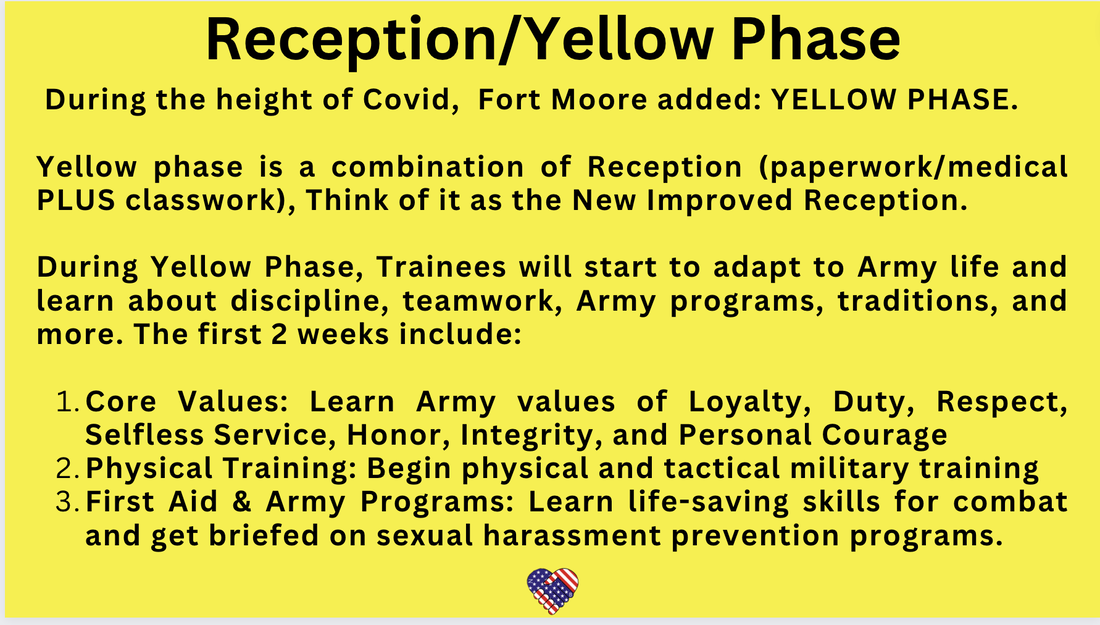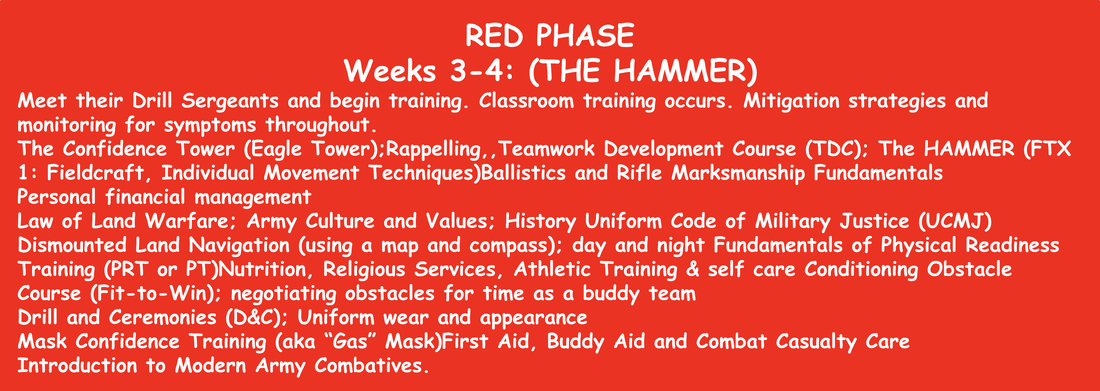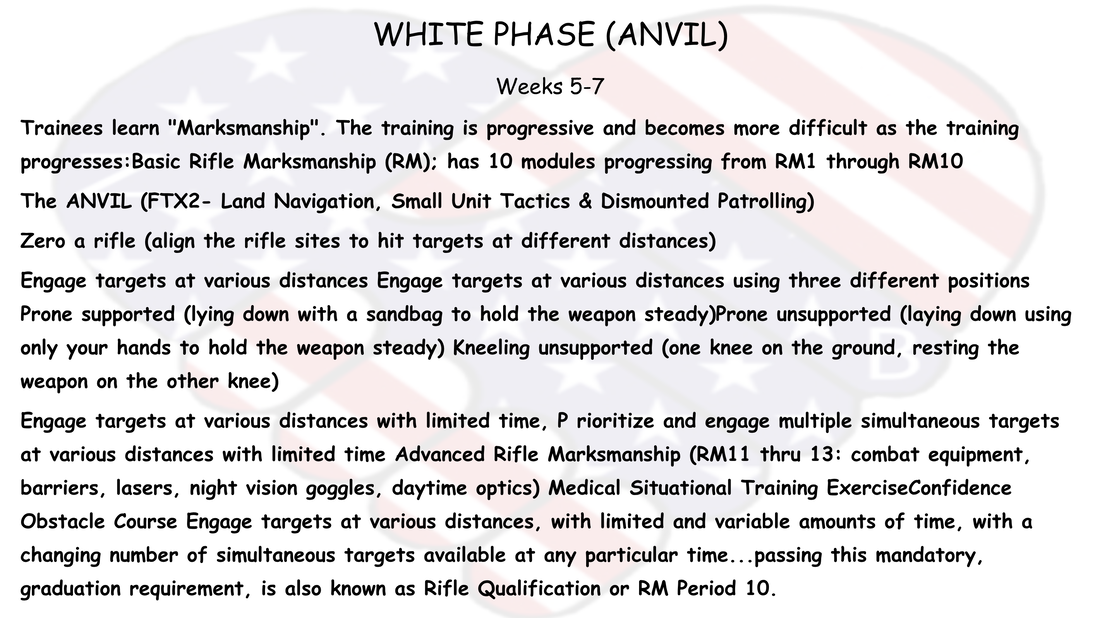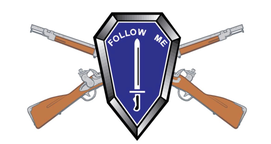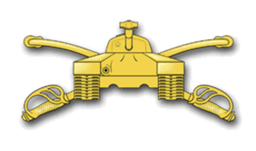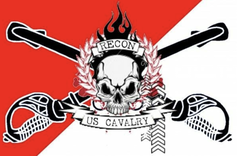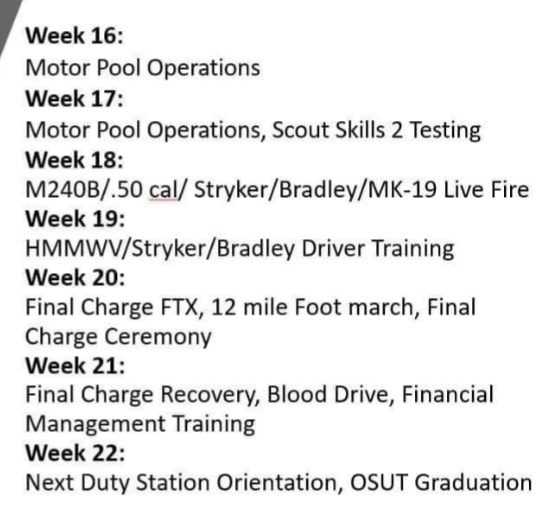Basic Combat Training
Red Phase (weeks 3-4)
Weeks 1-3: Trainees meet their Drill Sergeants and begin training. While often considered a difficult week for Trainees due to the adjustments, it is actually pretty easy compared to later weeks. Most classroom-type training occurs in this period where Trainees learn about:
- The Confidence Tower (Eagle Tower);Rappelling, cargo net and navigating rope bridges
- Teamwork Development Course (TDC); negotiate a series of mentally challenging obstacles as a team
- The HAMMER (FTX 1: Fieldcraft, Individual Movement Techniques)
- Ballistics and Rifle Marksmanship Fundamentals
- Personal financial management
- Law of Land Warfare; Army Culture and Values; History
- Uniform Code of Military Justice (UCMJ)
- Dismounted Land Navigation (using a map and compass); day and night
- Fundamentals of Physical Readiness Training (PRT or PT)
- Nutrition, Religious Services, Athletic Training & self care
- Conditioning Obstacle Course (Fit-to-Win); negotiating obstacles for time as a buddy team
- Drill and Ceremonies (D&C); Uniform wear and appearance
- Mask Confidence Training (aka “Gas” Mask)
- First Aid, Buddy Aid and Combat Casualty Care
- Introduction to Modern Army Combatives.
“White Phase“, is where soldiers begin actually firing weapons. With the service rifle, the M4 Carbine or M16A1 Assault Rifle, they will fire at various targets, which are progressively farther-and-farther down range, making each successive target more difficult to hit. You are required to shoot at least 28 out of the 40 targets that pop up. You will gain the skill of “Marksman”, “Sharpshooter”, or “Expert” depending on how many of the 40 targets you shoot. Additionally, there are pop-up targets at long range. Other weapons the soldier becomes familiarized with include various grenades (such as the M67 fragmentation grenade), grenade launchers (such as the M203 grenade launcher) and machine guns such as the M240B and M249 SAW “Squad Automatic Weapon”, Soldiers will also be familiarized with the M2 .50 caliber heavy machine gun, referred to as the “MA deuce”, as well as the MK-19 (called Mark 19) which shoots 40mm grenades over 3000 meters.
The second week of White Phase involves familiarization with anti-tank/armor weaponry and other heavy weapons. There is also an obstacle course which the soldiers are expected to negotiate in a certain amount of time. This is also known as the confidence course since the main objective of running the course is to build self-confidence. There is also the expectation of working as a team with the assigned Battle Buddy.
Additionally, there is continual, intense physical training, as well as drill and ceremony training. At the conclusion of White Phase, soldiers are expected to demonstrate proficiency with the various weaponry in which they trained, using numerous “go or no-go” (pass/fail) exercises, prior to being allowed to move on to Blue Phase. There will also be an off-record PT test in White Phase, which is for the drill sergeants to assess where you are in your physical fitness goals.
The second week of White Phase involves familiarization with anti-tank/armor weaponry and other heavy weapons. There is also an obstacle course which the soldiers are expected to negotiate in a certain amount of time. This is also known as the confidence course since the main objective of running the course is to build self-confidence. There is also the expectation of working as a team with the assigned Battle Buddy.
Additionally, there is continual, intense physical training, as well as drill and ceremony training. At the conclusion of White Phase, soldiers are expected to demonstrate proficiency with the various weaponry in which they trained, using numerous “go or no-go” (pass/fail) exercises, prior to being allowed to move on to Blue Phase. There will also be an off-record PT test in White Phase, which is for the drill sergeants to assess where you are in your physical fitness goals.
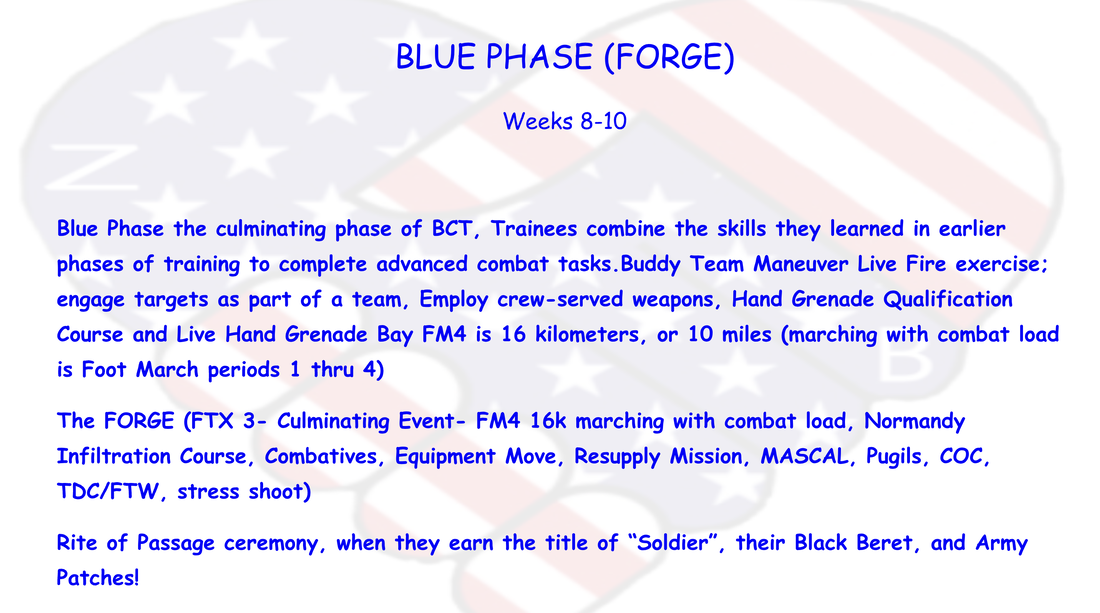
“Blue Phase” or “Warrior Phase” is the culmination and the most challenging of all the training phases. During this phase, there is a final official PT test. At some basic training locations, soldiers that fail are not allowed to go into the field with the rest of the platoon. The Final PT Test consists of the Standard Army Annual PT Examination. A minimum of 150 points (min. 50 points per PT event) is required to pass US Army Basic Training. Those that pass will move on to “field problems” (camping) and FTX (Field Training Exercises), such as nighttime combat operations and MOUT (Military Operations in Urban Terrain) training. There is no access to the dining facility during these exercises, so meals are given in the form of either MREs (Meal Ready to Eat). Drill sergeants will make much of this an adversarial process, working against the recruits in many of the night operations, trying to foil plans, etc.
Week 2 of Blue Phase (the 8th week of Basic Training) culminates in a special tactical FTX (Field Training Exercise), during which the drill sergeants will advise, but allow recruit platoon leaders and squad leaders to exercise primary decision-making. They attempt to make virtually every one of these exercises different. Because being a soldier is potentially an extremely hazardous job, recruits must demonstrate extreme aggression and fearlessness, tempered by intelligence and common sense. Only those that demonstrate these vital attributes will be permitted to move on to AIT.
Following their FTX, non-OSUT (Infantry, Cav Scouts and Armor are OUST), non-OSUT recruits then move into the final week of training, often called “recovery week”. At this time, soldiers must service and/or repair any items they are not taking on to AIT including weapons, bedding, issued equipment (helmet, canteen, gas mask, etc.) as well as ensuring the platoon barracks is in good order to receive the next platoon of trainees. This week also includes a final fitting of the recruit’s dress uniform as well as practice for the graduation ceremony which takes place at the end of the week.
For OSUT (Infantry, Cav Scouts, Armor) recruits, week 9 will be a continual of week 8. Week 9 will present new field challenges and additional training in order to refine you as an infantryman. After week 9, you will continue to learn and train on infantry skills throughout your AIT.
Week 2 of Blue Phase (the 8th week of Basic Training) culminates in a special tactical FTX (Field Training Exercise), during which the drill sergeants will advise, but allow recruit platoon leaders and squad leaders to exercise primary decision-making. They attempt to make virtually every one of these exercises different. Because being a soldier is potentially an extremely hazardous job, recruits must demonstrate extreme aggression and fearlessness, tempered by intelligence and common sense. Only those that demonstrate these vital attributes will be permitted to move on to AIT.
Following their FTX, non-OSUT (Infantry, Cav Scouts and Armor are OUST), non-OSUT recruits then move into the final week of training, often called “recovery week”. At this time, soldiers must service and/or repair any items they are not taking on to AIT including weapons, bedding, issued equipment (helmet, canteen, gas mask, etc.) as well as ensuring the platoon barracks is in good order to receive the next platoon of trainees. This week also includes a final fitting of the recruit’s dress uniform as well as practice for the graduation ceremony which takes place at the end of the week.
For OSUT (Infantry, Cav Scouts, Armor) recruits, week 9 will be a continual of week 8. Week 9 will present new field challenges and additional training in order to refine you as an infantryman. After week 9, you will continue to learn and train on infantry skills throughout your AIT.
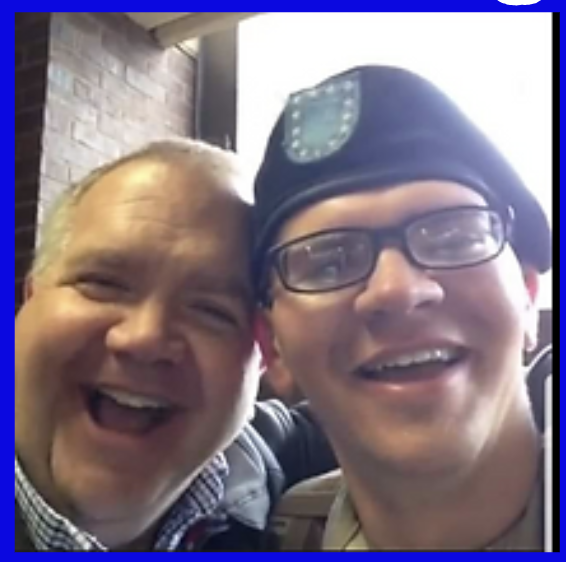 Tim Bates @ Zach's Family Weekend, right after the Turning Green Ceremony!! Look how happy they are! It was also HBL (Holiday Block Leave), so he got to come home for 2 weeks!
Tim Bates @ Zach's Family Weekend, right after the Turning Green Ceremony!! Look how happy they are! It was also HBL (Holiday Block Leave), so he got to come home for 2 weeks!
Infantry, Tankers, and Cav Scouts all do One Station Unit Training (OSUT) combining BCT and AIT. At the completion of the BCT portion of training, on the first day of Family Weekend, they will hold a Family Day Ceremony to honor their Rite of Passage. This ceremony may be called a "Turning Green" Ceremony, a "Transition" Ceremony, or simply a "Family Day" Ceremony ~ but it is NOT Graduation! They do not have Graduation until AFTER the completion of both BCT & AIT portions of training, at the end of OSUT. Typically the Soldier has Turning Green Ceremony and released for the remainder of the day until a specific time. The next two days, they will also be released with a return time each evening. Every Company/Troop does things a bit differently on times, as well as dates. Please follow your Soldier's Official Company page to get the most up to date information on this event.
AIT
You must be a member of our
https://www.facebook.com/groups/fortmooreosutsupport group for AIT information.
Advanced Individual Training, is where new soldiers receive specific training in their chosen MOS.
You must be a member of our
https://www.facebook.com/groups/fortmooreosutsupport group for AIT information.
Advanced Individual Training, is where new soldiers receive specific training in their chosen MOS.
Click on the MOS You Need
InfantryBLACK PHASE:WEEKS 10-13
|
TankerBLACK PHASE:WEEKS 10-13
BLACK PHASE -
FTX and gunnery
|
Cav ScoutBLACK PHASE:WEEKS 10-13
(fully transitioning to 22 wk Training Program by October 2020) BLACK PHASE - Black phase is dedicated to the development of technical and tactical Scout skills. Troopers will complete training on a variety of weapon systems to include the M320 Grenade Launcher, M240B Machine Gun, MK-19 automatic grenade launcher, and anti-armor missile systems. Further, they will learn advanced land navigation and dismounted Scout tactics. Trainees will also become familiar with their inventory of vehicles that include the HMMWV (High Mobility Multi-wheeled Vehicle), the Stryker Vehicle, and the Bradley Cavalry Fighting Vehicle. This phase culminates with the “Saber Challenge” Phase Test where Soldiers must demonstrate proficiency on critical Scout skills. Failure to meet the standard in this test will result in a recycle to the beginning of black phase. GOLD PHASE:WEEKS 14-22 Comprised of several culminating events designed to prepare the Cavalry Scout for his/her first duty station. Trainees will complete a week long live fire training exercise where they will fire the M240, MK-19, M2 .50 caliber machine gun. Some Trainees will fire the M242 25mm Bushmaster cannon on the Cavalry Fighting Vehicle. Following the live fire training, the Trainees will conduct a five day end of cycle field training exercise which culminates with a 12-mile foot march. Trainees will also have to pass an APFT as well as a high physical demands test to meet graduation requirements. Following the end of cycle field training exercise, Trainees will conduct one week of recovery and one week to prepare for graduation activities and onward movement to their next duty station. |
